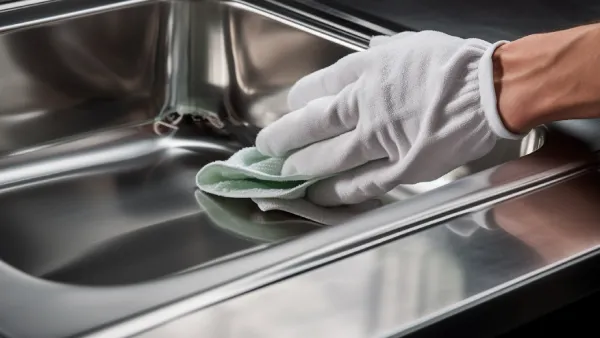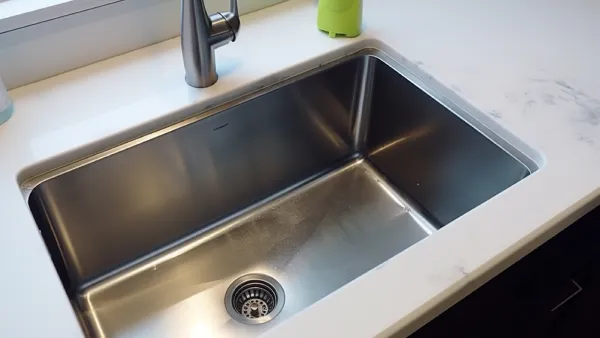Last Updated on November 14, 2023
Stainless steel sinks are popular for many homeowners, but they’re hard to keep shining because of scratch marks. Scratches on stainless steel sinks can ruin their appearance and even lead to corrosion. Therefore, you should protect your sink and keep it scratch-free.
When cleaning the sink, opt for soft materials like microfiber cloths, nylon scrubbers, or non-abrasive sponges. Be careful when dropping heavy objects into the sink, which can cause dents and scratches.
Also, using a sink grid or roller mats can provide a protective barrier between your dishes and the sink surface. Throughout this article, you will explore how to keep your sink looking pristine. So keep reading to protect your stainless steel sink from abrasion.
How to Prevent Stainless Steel Sink From Scratching: Try These Methods

You can take several methods to prevent the stainless steel sink from getting scratched.
- Use soft cleaning tools
- Use a sink grid
- Use roller mats
- Soften the blow
- Avoid heavy impact
- Don’t cut directly in the sink
- Directional cleaning
- Silicone sink protectors
- Soften water
- Apply sink wax or polish
1. Use Soft Cleaning Tools
Use soft cleaning tools such as microfiber cloths or non-abrasive sponges when cleaning your stainless steel sink. Non-abrasive sponges are a good option, especially for tougher stains requiring more scrubbing. These materials are gentle enough to clean your sink without causing any scratches to the surface.
Avoid using steel wool or abrasive brushes, which can leave unsightly scratches on your sink. Microfiber cloths are great for everyday cleaning as they’re soft, absorbent, and effective in removing dirt and grime.
2. Use a Sink Grid
You can prevent scuff marks on your kitchen stainless steel sink by placing a sink grid in the bottom. A sink grid is a practical solution to protect the surface of your sink from pots, pans, and utensils that can cause scratches.
These grids are specially designed to fit perfectly in your sink, creating a barrier between the sink’s surface and any potential scratching objects.
3. Use Roller mats
Roller mats are a practical and effective solution to prevent your stainless steel sink from getting scratched. These mats can be positioned on the worktop next to or over the sink for draining. Not only do they protect your sink, but they also serve as a handy stand for hot pots and pans.
The roller mats, like the one from John Lewis, are designed with durability and can withstand heavy cookware’s weight. They’re easy to clean and maintain, making them a convenient addition to your kitchen.
4. Use a Rubber Sink Mat
Use a rubber kitchen sink mat to soften the blow of heavy or sharp objects to safeguard your stainless steel kitchen sink from scratches. A rubber sink mat can act as a cushion, absorbing the impact and preventing scratches.
Simply place the mat at the bottom of your sink before washing these items. The rubber material is gentle on your kitchen sink’s surface, providing a protective barrier.
5. Avoid Heavy Impact
To prevent scratching, avoid heavy impact. When handling heavy objects, gently place them into the sink to minimize the force of impact.
If you need to wash heavy dishes or utensils, consider using a plastic mat to provide extra protection for your sink. Also, installing a sink grid or a rubber mat can help prevent scratches caused by pots and pans.
6. Don’t Cut Directly into the Sink
Don’t use knives directly in the sink, as it can cause scratches on the stainless steel surface. Always use a cutting board when chopping or cutting ingredients to prevent this.
It may seem convenient to cut directly in the sink, but the sharp edges of knives can easily leave permanent marks on the kitchen sink’s surface. Cutting boards provide a protective barrier, preventing direct contact between the knife and the sink.
7. Directional Cleaning
Clean and wipe your sink along the grain lines, if visible, as this helps prevent fine scratches from forming.
To do this, start by rinsing the sink with warm water to remove loose stuff. Then, apply a small amount of mild dish soap to a soft sponge or cloth and gently scrub the sink, following the grooves of the grain lines.
8. Silicone Sink Protectors
Silicone sink protectors or sink mats are a great solution to protect your sink and keep it looking brand new. These protectors are designed to fit the contours of your sink, providing an additional layer of protection against scratches caused by pots, pans, and utensils.
Made from durable silicone material, they’re heat resistant and can withstand high temperatures without melting or deforming. Simply place the sink protector at the bottom of your sink to create a cushioned surface that prevents direct contact between your stainless steel sink and any potentially abrasive objects.
9. Soften Water
Hard water contains high levels of minerals, such as calcium and magnesium, which can leave behind deposits on your sink’s surface. Over time, these deposits can build up and cause scratches or dullness. You can soften water with a water softener to prevent your kitchen stainless steel sink from being scratched.
By using a water softener, you can remove these minerals from your water supply, ensuring that your sink remains in pristine condition. Water softeners exchange calcium and magnesium ions with sodium ions through ion exchange.
10. Apply Sink Wax or Polish
To prevent scratches on your stainless steel sink, apply a sink wax or polish according to the manufacturer’s instructions. Sink wax or polish creates a protective layer on the surface of the stainless steel, preventing any abrasive materials from scratching it.
Before applying the wax or polish, thoroughly clean the sink using a gentle cleanser and a soft cloth or sponge. Once the sink is clean and dry, apply a small amount of the wax or polish to a clean cloth and rub it onto its surface in circular motions. Make sure to cover the entire sink, including the edges and corners.
Why is my stainless steel sink getting scratched?

Stainless steel sinks often come with a protective anti-rust coating that can be prone to scratching. This coating is essential for maintaining the sink’s corrosion resistance but may not be as resilient as the stainless steel itself.
Also, tiny and hard particles in cleaning materials or food debris can act as abrasives when scrubbed against the sink’s surface. Over time, these abrasives can create small scratches. Using abrasive scouring pads or steel wool for cleaning is a common mistake that exacerbates this issue.
Do all stainless steel kitchen sinks scratch easily?
All stainless steel kitchen sinks indeed have the potential to get scratched, but not all of them scratch easily. The susceptibility to scratches depends on the quality and thickness of the stainless steel used in the sink. High-quality sinks with thicker stainless steel are less likely to scratch easily than lower-quality sinks.
Keep Your Stainless Steel Sink Looking Pristine With These Simple Tips
Maintaining your stainless steel sink’s pristine appearance and longevity is not a challenge but a matter of adopting a few key practices. Safeguarding your sink with non-abrasive cleaning tools and employing a sink grid or mat can act as a protective barrier.
With these simple yet effective maintenance practices, your stainless steel sink will stay in great shape for a long time. So, treat your sink carefully, and it will reciprocate with enduring beauty and functionality.


